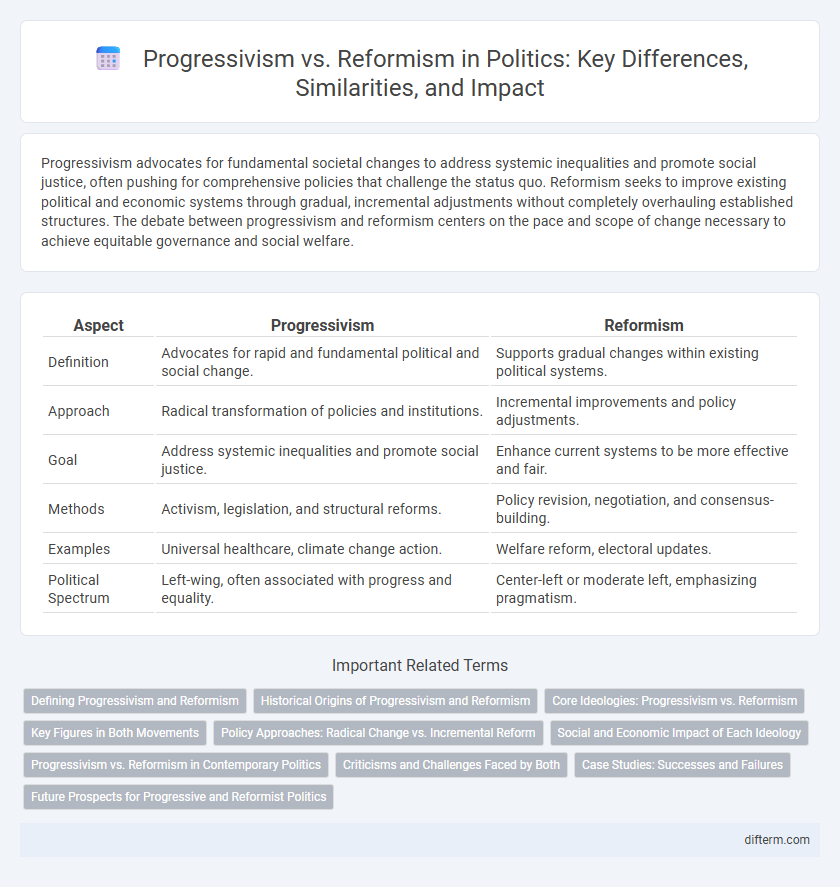Progressivism advocates for fundamental societal changes to address systemic inequalities and promote social justice, often pushing for comprehensive policies that challenge the status quo. Reformism seeks to improve existing political and economic systems through gradual, incremental adjustments without completely overhauling established structures. The debate between progressivism and reformism centers on the pace and scope of change necessary to achieve equitable governance and social welfare.
Table of Comparison
| Aspect | Progressivism | Reformism |
|---|---|---|
| Definition | Advocates for rapid and fundamental political and social change. | Supports gradual changes within existing political systems. |
| Approach | Radical transformation of policies and institutions. | Incremental improvements and policy adjustments. |
| Goal | Address systemic inequalities and promote social justice. | Enhance current systems to be more effective and fair. |
| Methods | Activism, legislation, and structural reforms. | Policy revision, negotiation, and consensus-building. |
| Examples | Universal healthcare, climate change action. | Welfare reform, electoral updates. |
| Political Spectrum | Left-wing, often associated with progress and equality. | Center-left or moderate left, emphasizing pragmatism. |
Defining Progressivism and Reformism
Progressivism advocates for fundamental societal changes through government intervention to address systemic inequalities and promote social justice, emphasizing transformative policies in areas like healthcare, education, and environmental protection. Reformism seeks to improve existing political and economic systems incrementally, prioritizing gradual adjustments and policy reforms without overturning foundational institutions. Both ideologies aim for social betterment but diverge in their approaches to change, with progressivism favoring radical shifts and reformism emphasizing continuity and cautious improvement.
Historical Origins of Progressivism and Reformism
Progressivism originated in the late 19th and early 20th centuries as a response to industrialization and social inequalities, emphasizing widespread social reforms and the expansion of democracy to address systemic issues. Reformism emerged during the same period but focused more on gradual improvements within existing political and economic structures, advocating for regulatory measures and incremental policy changes. Historical progressivism is closely linked to movements like the American Progressive Era and European social democracy, while reformism draws from liberal traditions emphasizing pragmatic and steady socio-political evolution.
Core Ideologies: Progressivism vs. Reformism
Progressivism advocates for fundamental societal transformation through systemic changes addressing inequality and social justice at structural levels. Reformism emphasizes gradual improvements within existing political and economic frameworks, aiming to enhance social welfare without overhauling institutions. Core ideologies of progressivism center on challenging power dynamics and promoting equity, while reformism prioritizes pragmatic policy adjustments and incremental legislative progress.
Key Figures in Both Movements
Key figures in progressivism include Theodore Roosevelt and Jane Addams, who championed social justice and governmental intervention to address inequality. Reformism features leaders like Franklin D. Roosevelt and Woodrow Wilson, advocating for gradual change through policy reforms within existing political structures. Both movements emphasize improving society but differ in their approaches and historical impact through these influential personalities.
Policy Approaches: Radical Change vs. Incremental Reform
Progressivism advocates for radical change through comprehensive restructuring of social, economic, and political systems to address systemic inequalities, emphasizing transformative policies such as universal healthcare and wealth redistribution. Reformism favors incremental reform, promoting gradual policy adjustments within existing frameworks to achieve steady improvements like expanding social welfare programs and enhancing regulatory oversight. The divergence lies in progressivism's emphasis on systemic overhaul versus reformism's strategy of evolutionary change through legislative refinement and institutional adaptation.
Social and Economic Impact of Each Ideology
Progressivism drives transformative social policies aimed at reducing inequality through systemic changes, often advocating for wealth redistribution and extensive government intervention in the economy. Reformism seeks gradual improvements within existing political and economic frameworks, emphasizing incremental policy adjustments to enhance social welfare and economic stability. The social impact of progressivism often includes expanded civil rights and public services, while reformism tends to preserve institutional continuity, promoting economic growth with moderated social equity advancements.
Progressivism vs. Reformism in Contemporary Politics
Progressivism in contemporary politics emphasizes systemic change through transformative policies addressing social justice, economic inequality, and environmental sustainability, often advocating for bold government intervention. Reformism, by contrast, supports incremental policy adjustments within existing political frameworks to improve governance and social conditions without radical disruption. The debate between progressivism and reformism centers on the scope and pace of change necessary to achieve equitable and sustainable political outcomes.
Criticisms and Challenges Faced by Both
Progressivism faces criticism for its perceived reliance on idealistic goals that may outpace pragmatic implementation, leading to challenges in gaining broad political support. Reformism is often challenged by accusations of being too incremental, potentially stalling necessary systemic changes and satisfying entrenched interests rather than addressing root problems. Both ideologies struggle with balancing immediate policy impacts against long-term societal transformation, often encountering resistance from established political and economic structures.
Case Studies: Successes and Failures
Progressivism achieved significant reforms in areas like labor rights and environmental protection through bold legislative initiatives, exemplified by the New Deal and the Civil Rights Movement. In contrast, reformism often pursued incremental changes, with mixed results such as the Affordable Care Act's expansion of healthcare access but limited systemic transformation. Case studies reveal progressivism's strength in mobilizing grassroots movements, while reformism excels in securing bipartisan support, highlighting the strategic trade-offs in political change efforts.
Future Prospects for Progressive and Reformist Politics
Progressivism emphasizes systemic change aimed at addressing structural inequalities through bold policy innovations such as universal healthcare and climate justice. Reformism advocates for incremental improvements within existing political frameworks, focusing on pragmatic solutions like expanding social welfare and enhancing regulatory measures. Future prospects indicate that progressive movements may gain momentum among younger, more diverse electorates, while reformist politics remain influential in achieving gradual policy advancements through bipartisan cooperation.
progressivism vs reformism Infographic

 difterm.com
difterm.com